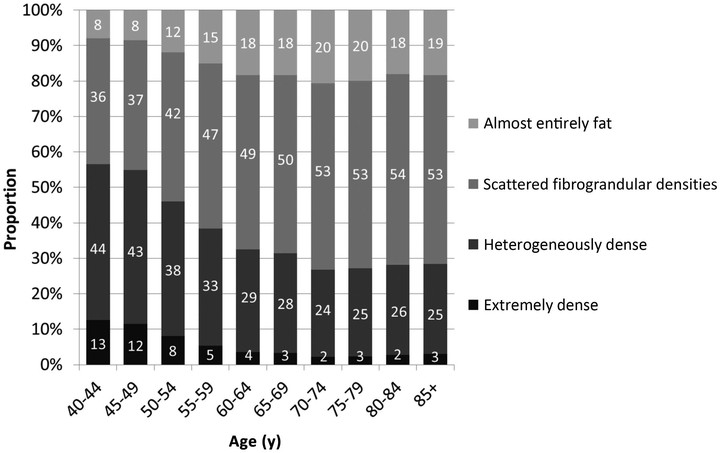
Abstract
BACKGROUND: National legislation is under consideration that would require women with mammographically dense breasts to be informed of their breast density and encouraged to discuss supplemental breast cancer screening with their health care providers. The number of US women potentially affected by this legislation is unknown. METHODS: We determined the mammographic breast density distribution by age and body mass index (BMI) using data from 1518 599 mammograms conducted from 2007 through 2010 at mammography facilities in the Breast Cancer Surveillance Consortium (BCSC). We applied these breast density distributions to age- and BMI-specific counts of the US female population derived from the 2010 US Census and the National Health and Nutrition Examination Survey (NHANES) to estimate the number of US women with dense breasts. RESULTS: Overall, 43.3% (95% confidence interval [CI] = 43.1% to 43.4%) of women 40 to 74 years of age had heterogeneously or extremely dense breasts, and this proportion was inversely associated with age and BMI. Based on the age and BMI distribution of US women, we estimated that 27.6 million women (95% CI = 27.5 to 27.7 million) aged 40 to 74 years in the United States have heterogeneously or extremely dense breasts. Women aged 40 to 49 years (N = 12.3 million) accounted for 44.3% of this group. CONCLUSION: The prevalence of dense breasts among US women of common breast cancer screening ages exceeds 25 million. Policymakers and healthcare providers should consider this large prevalence when debating breast density notification legislation and designing strategies to ensure that women who are notified have opportunities to evaluate breast cancer risk and discuss and pursue supplemental screening options if deemed appropriate.